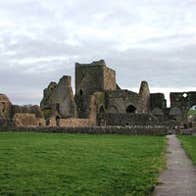The Rock of Cashel is one of Ireland’s most visited attractions and is a spectacular archaeological site. A collection of medieval ecclesiastical buildings set on an outcrop of limestone in the Golden Vale. The 12th-century round tower is the oldest surviving building on the Rock, which also include a high cross and the ruins of a Romanesque chapel. 'Cormac's Chapel' is one of the earliest and finest churches built in the Romanesque style. The 13th-century Gothic Cathedral is a large cruciform Gothic church without aisles, built between 1230 and 1270. There is also a 15th-century castle and the 'Hall of the Vicars' is the entry point to the ecclesiastical enclosure. The Hall houses the museum where the original Cross of St. Patrick can be found.
The site includes an audio-visual show and exhibitions. The Rock of Cashel, also known as 'St. Patrick’s Rock' is located just 500 metres from the centre of Cashel Town in County Tipperary.
The Rock of Cashel is an ancient royal site of the Kings of Munster and first attained importance as a fortress. Its origins as a centre of power go back to the 4th or 5th centuries. Two of the most famous people of Irish legend and history are associated with the Rock of Cashel. They are St. Patrick whom according to legend, arrived in Cashel in AD 432 and baptized King Aengus who became Ireland’s first Christian ruler. The second was Brian Boru, he was crowned High King here in 990. He is the only King who was able to unite all of Ireland under one ruler for any significant period of time.
Please note this is a very busy site and visitors may experience a delay during the summer months.
Stand on top of the Rock. Look across the field, you can see the ruins of Hore Abbey, Ireland's last medieval Cistercian monastery.

